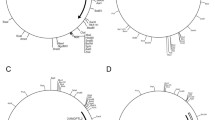Abstract
One novel cDNA fragment was obtained from vascular endothelial cells by differential display reverse transcription PCR technique. By using this fragment as probe, we screened the human artery cDNA library and obtained one cDNA clone which is 2198 bp in length. After sequencing and homology researching, we found that the clone contained a region of 851 bp in length complementary to that of humanangiopoietin-1 cDNA, encoding the partial fibrinogen-like domain and 3′ non-translational region. It was inferred that this clone was a naturally occurring antisense RNA of humanangiopoietin-1, designated asGna-1. Gna-1 does not encode protein. The transcription ofGna-1 in human umbilical vein endothelial cells and ECV304 cells was confirmed by RT-PCR method.Gna-1 may be involved in regulating the function ofangiopoietin-1, and play a significant role in angiogenesis.
Similar content being viewed by others
References
Folkman, J., Angiogenesis in cancer, vascular, rheumatoid and other disease, Nature Med., 1995, 1: 27–31.
Hanahan, D., Folkman, J., Patterns and emerging mechanisms of the angiogenic switch during tumorigenesis, Cell, 1996, 86(3): 353–364.
Davis, S., Aldrich, T. H., Jones, P. F. et al., Isolation of angiopoietin-1, a ligand for the TIE2 receptor, by secretion-trap expression cloning, Cell, 1996, 87: 1161–1169.
Suri, C., Jones, P. F., Patans, S. et al., Requisite role of angiopoietin-1, a ligand for the TIE2 receptor, during embryonic angiogenesis, Cell, 1996, 87: 1171–1180.
Papapetropolous, A., Garcia-Cardena, G., Dengler, T. J. et al., Direct actions of angiopoietin-1 on human endothelium: evidence for network stabilization, cell survival, and interaction with other angiogenic growth factors, Laboratory Investigation, 1999, 72: 213–223.
Maisonpierre, P. C., Suri, C., Jones, P. F. et al., Angiopoietin-2, a natural antagonist for TIE2 that disrupts in vivo angiogenesis, Science, 1997, 277: 55–60.
Valenzuela, D. V., Griffiths, J. A., Rojas, J. et al., Angiopoietins 3 and 4: diverging gene counterparts in mice and humans, PNAS, 1999, 96: 1904–1909.
Wei Yingjie, Ding Jinfeng, Zhao Yong et al., Construction of human adult artery and heart cDNA libraries and cloning of novel full-length cDNAs, Chinese Circulation Journal (in Chinese), 1999, 14: 369–371.
Sambrook, J., Fritsch, E. F., Maniatis, T., Molecular Cloning, New York: Cold Spring Harbor Laboratory Press, 1989, 139–282.
Dolnick, B. J., Naturally occurring antisense RNA, Pharmacol. Ther., 1997, 75: 179–184.
Jones, N., Master, Z., Jones, J. et al., Identification of Tek/Tie2 binding partners, The Journal of Biological Chemistry, 1999, 274: 30896–30905.
Kindy, M. S., McCormack, J. E., Bucjler, A. J. et al., Independent regulation of transcription of the two strands of the c-myc gene, Mol. Cell Biol., 1987, 7: 2857–2862.
Wu, J., Grindlay, G. J., Bushel, P. et al., Negative regulation of the human epsilon-globin gene by transcriptional interference: role of an Alu repetitive element, Mol. Cell Biol., 1990, 10: 1209–1216.
Author information
Authors and Affiliations
Corresponding author
Additional information
The sequence reported in this paper has been accepted by GenBank with an accession number 209975.
Rights and permissions
About this article
Cite this article
Zhang, K., Chen, B., Wu, G. et al. Molecular cloning and identification of naturally occurring human antisenseangiopoietin-1: Gna-1 . Sci. China Ser. C.-Life Sci. 44, 314–320 (2001). https://doi.org/10.1007/BF02879338
Received:
Issue Date:
DOI: https://doi.org/10.1007/BF02879338




